Top News
March 12, 2013 Ryukyu Shimpo
Air China International has decided that on July 3 it will resume flights between Beijing and Naha that have been suspended since last October. The airline will operate this return service twice a week on Wednesday and Saturday. The company had canceled the service because of anti-Japanese demonstrations against Japan’s nationalization of the Senkaku Islands. Staff at the Okinawa branch of Air China International said that they have not yet received an explanation from their head office regarding the resumption of the service. Hainan Airlines, one of the largest Chinese airlines, has also decided to resume its Beijing-Naha service on May 2.
Shigenobu Asato, chairman of the Convention & Visitors Bureau Okinawa, commented on the resumption of Air China’s flights, saying, “The number of tourists from China has decreased since the turmoil over the Senkaku Islands. It is significant that the airlines are moving to resume their services.” He went on to say, “Working with travel companies we want to strengthen our efforts to maintain a stable operation.”
Yoshiro Shimoji, the deputy director general in charge of tourism in the Okinawa Prefectural Government, commented, “We will collect information through staff in Beijing and will consider a range of measures, including promotional projects with travel agencies and airlines to attract Chinese tourists to use these flights.”
(English translation by T&CT, Mark Ealey)
Go to Japanese

March 15 2013 Ryukyu Shimpo
On March 14, four F/A 18 Hornets belonging to units based at Marine Corps Air Station Iwakuni took off from Kadena Air Base.
The fighter aircraft are reported to have conducted training over the sea around Okinawa, where they dropped at least 14 of the 18 cluster bombs they were carrying.
About two and a half years have passed since September 2010 when these aircraft last carried cluster bombs. Kadena currently hosts around 20 Hornets. It has been confirmed that the F/A 18 Hornets that took off Kadena Air Base on that day, carried 250 kg bombs, 500 kg bombs and 500 kg precision-guided bombs in addition to the cluster bombs, which are prohibited in a growing number of countries.
(English translation by T&CT, Mark Ealey)
Go to Japanese

Go To Video
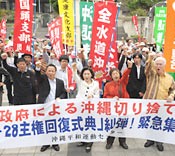
March 14, 2013 Ryukyu Shimpo
Okinawans are critical of the Japanese government planning to hold a ceremony on April 28 to commemorate the anniversary of the restoration of Japanese sovereignty after the San Francisco Peace Treaty took effect in 1952. The people of Okinawa see this date as a day of humiliation because Okinawa, along with the Amami Islands in Kagoshima Prefecture, was separated from Japan and placed under U.S. occupation on that day.
In a memorandum called the “Emperor of “Emperor of Japan’s message,” Emperor Showa was quoted in 1947 as requesting that the U.S. government continue the military occupation of Okinawa for an extended period of time. Many believe that the memorandum had a significant influence on the conclusion of the San Francisco Peace Treaty. With regard to the Japanese Imperial couple’s attendance at the upcoming commemorative ceremony, Okinawan intellectuals criticize the aggressive “pre-war approach” of the current administration led by Prime Minister Shinzo Abe who wants to revise the constitution and have the Emperor as the Head of State. The intellectuals suggest that, “The central government is using the Japanese Emperor for political purposes.”
The current Emperor first visited Okinawa as crown prince in 1975 and has visited Okinawa a total of nine times. In his birthday press conference last December, the Emperor mentioned his visit to Okinawa the previous month, saying, “I am aware that Okinawa struggles with various issues. I think that it is important for all the people of the main islands of Japan to think of the hardships of the Okinawan people.”
On March 13, the day after the Japanese cabinet decided to hold the ceremony, at Okinawa Resident Plaza in Naha the Okinawa Peace Movement Center held a protest rally against the decision. Participants shouted angry comments directed against the central government, such as, “We cannot allow the central government to hold this ceremony.”
Terminology: Emperor of Japan’s message
The so-called “Emperor of Japan’s message” is a memorandum that a U.S. political advisor on Japan, William Joseph Sebald, wrote for General Douglas MacArthur entitled “Emperor of Japan’s Opinion Concerning the Future of the Ryukyu Islands.” Through one of his advisors, Hidenari Terasaki, Emperor Showa verbally requested that the U.S. government continue the military occupation of Okinawa for an extended period of time. In the memorandum, the Emperor was quoted as saying, “Such a move would meet with widespread approval among the Japanese people who fear not only the menace of Russia, but after the Occupation has ended, the growth of rightist and leftist groups which might give rise to an ‘incident’ which Russia could use as a basis for interfering internally in Japan.” Eiichi Shindo released the document in 1979 in SEKAI, a Japanese monthly journal published by Iwanami Shoten.
(English translation by T&CT, Mark Ealey)
Go to Japanese
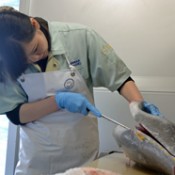
March 10, 2013 Masaki Umeda of Ryukyu Shimpo
Recently, an 18 year-old woman who works at the seafood market Osakana Center in the Itoman Roadside Station in Itoman, has attracted praise for her skill at slicing up tuna. Wakana Nohara from Ozato, Nanjo, has been cutting up three or four tuna a day from the middle of February. It is said that teenagers who can do this well are very rare, and a superior at work commented that he has never seen anyone with as much natural ability as Nohara.
After graduating from high school, last April Nohara started working at the Okinawan major food manufacturer Hokugan Co. She was assigned to Anmar in the Osakana Center where to begin with she worked as a cashier, sometimes helping to pack fish. She said, “I was really impressed when I saw the men slicing up the tuna, so I’d always wanted to try it myself.” Interested in how it was done, Nohara watched a co-worker cutting up tuna while she was working. She recorded exactly what they did on the camera on her cellphone and then practiced at home.

On February 28, Wakana Nohara (right) and her co-worker Shuzen Higa at the Osakana Center of the Itoman Roadside Station in Itoman.
In mid-February this year, Nohara asked if she could be allowed to cut up a tuna and showed remarkable ability despite it being her first time. Veteran worker Shuzen Higa was surprised at Nohara’s skill, saying, “I didn’t really concentrate too hard on teaching her, but the day after I showed her how to do it she was able to cut up a tuna by herself. It was hard to believe that she is a beginner.”
Tuna is a hot-selling product for fish merchants, and its price ranges from 2000 to 3000 yen per kilogram. That is why people who cut up tuna need to be very skillful at cutting the meat off the bone to avoid any waste. Nohara has already been entrusted with cutting up most of a tuna by herself.
“Some customers show great interest in her cutting up tuna. I hope that this will help make fish more popular,” said Higa.
Nohara said that when she started the job she never thought that she would work cutting fish. She is now capable of cutting up a tuna of about 20 kilograms and she aims to some day cut up a tuna that weighs more than she does. Nohara said, “It’s great when customers say that the tuna I cut up is tastes really good. I really want to push myself to be as good as the male workers.”
(English translation by T&CT, Lima Tokumori and Mark Ealey)
Go to Japanese
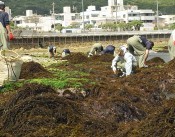
March 11, 2013 Ryukyu Shimpo
This year’s hijiki seaweed harvest began on the morning of March 10 along the coast at Itarashiki in Yonabaru. This brown seaweed found on rocky coastlines is a local specialty of Yonabaru. Members of the Fisheries Cooperative in Nishihara and Yonabaru used sickles to harvest seaweed that had grown to a length of about 80 centimeters. The harvesting will continue until late May.
On March 10, about 20 people began cutting after they had prayed for a good harvest and safety at four separate locations, including the processing plant, on the coastline and at a place of worship.
Satoshi Toma, the head of the cooperative, said, “We produced about 50 tons last year, but thanks to more appropriate weather conditions than last year the hijiki has grown well this season. I think that we can look forward to a good harvest; maybe 60 tons in all.”
(English translation by T&CT, Mark Ealey)
Go to Japanese

Go To Video
March 11, 2013 Tamiko Suzuki Correspondent of Ryukyu Shimpo
Through his website entitled REMEMBERING OKINAWA HISTORY, American veteran Donn Cuson, who currently resides in the suburbs of Tucson, Arizona, provides information on Okinawan history under the U.S. occupation from 1945 to 1972.
Cuson said that as the years pass information on the Okinawa of that time is becoming increasingly scarce. He hopes that the website will serve to remind people of the postwar history of Okinawa, and help to keep memories fresh.
Cuson went on to say that he has created a log of postwar Okinawan events that he wants both Americans and Japanese to know about. He said that many young people do not know what happened in postwar Okinawa, how their grandparents and parents who survived the battle lived after the war had ended, or that the U.S. military was committed to contributing to the reconstruction of Okinawa. Cuson says that all of the materials that he has collected are useful for understanding Okinawa’s postwar history.
The website provides snapshots of urban scenes and views of U.S. military bases, Naha and Koza City (currently Okinawa City), people engaging in their jobs and the daily life of Okinawans through the postwar period. Cuson has also posted an intriguing video of Naminoue during the 1960s. In addition, the website introduces postcards, postage stamps of Okinawa, Okinawan karate, various relics and memorabilia, and readers’ comments.
Cuson provided the Ryukyu America Historical Research Society with 151 separate materials that he collected during the period from 1945 to 1972, something that the Ryukyu Shimpo has previously published an article about.
Cuson, who turns 70 this year, joined the U.S. Air Force in 1963. Stationed at Kadena Air Base, he was in Okinawa for a total of four years. Somehow linked by fate, Cuson went on to marry Kim, who was originally from Naha. After his retirement from the armed forces, Cuson worked in the aerospace industry as a microelectronics manufacturer and worked on notable projects such as the landing on the moon. He obtained a bachelor’s degree in business and a master’s degree in engineering.
After that, Cuson became a lieutenant commander in the Navy Reserve. During that time, he worked for a private company as an electrician, setting up factories in South Korea and China, as well as managing manufacturing processes and facilities.
Cuson said that his stay in Okinawa was a very meaningful period in his life. He went on to say that he launched the website after thinking about Okinawa in the old days because he thought that Okinawa had changed so much.
Cuson’s website can be found at www.rememberingokinawa.com
(English translation by T&CT, Mark Ealey)
Go to Japanese
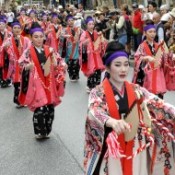
March 3, 2013 Ryukyu Shimpo
On March 1, or January 20 in the old lunar calendar, at Tsuji in Naha, one of New Year’s traditional events called hachika sogachi was organized by the Tsuji Shinshikai Foundation and other groups. Women who are Okinawan shaman or kaminchu visited places of worship in Tsuji, and prayed for business success and a good harvest. After that, women dressed in beautiful costumes made of bingata, Okinawan traditional resist dyed cloth, performed the juri-uma dance to pray to the gods as they jingled bells and yelled out “Yui yui.” History has it that the annual juri-uma parade provided an opportunity for women called juri, who worked in the entertainment area in Tsuji, a chance to be seen by their families. It is said that these women established a highly-developed social culture. The head of the event organizer Anmei Uezu, who is also a board member of the foundation, said, “We would like to pay tribute to the efforts and achievements of the women who developed the culture here.”
(English translation by T&CT, Lima Tokumori and Mark Ealey)
Go to Japanese

Go To Video
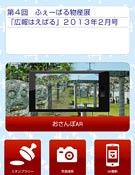
March 5, 2013 Ryukyu Shimpo
On March 3, the Haebaru Municipal Office introduced publically accessible WiFi and, using what is called “augmented reality,” commenced a town guide app service for smart phones under the name Haebaru Sightseeing Navi. Following on from Nanjo, Haebaru is the second location in Okinawa to launch a town guide app service. It provides tourist information, GPS, a stamp rally, photographs with the town mascot character called “Haerun” and other frame functions, plus a guide map in four languages: English, simplified and traditional Chinese and Korean. This language function is the first of its kind in Okinawa. A general portal website will also open to deliver tourist, administrative and events information.
Part of the tourist-friendly area promotion project that started in 2012, the service is funded by a grant the town received from the central government. On March 3, Vice Mayor Shinsho Kuniyoshi introduced the project at the Ryukyu Kasuri Hall in Haebaru and demonstrated augmented reality on Kasuri Road. He said, “We want to use information technology to introduce our town to people both inside and outside of Okinawa.”
WiFi towers have been installed on top of the municipal office and Kasuri Hall and provide coverage for the area.
The municipal office provided 2.7 million yen in fiscal 2012 for the project, and plans to expand the WiFi system, add more functions to the app and further enhance the portal website.
(English translation by T&CT, Hitomi Shinzato and Mark Ealey)
Go to Japanese
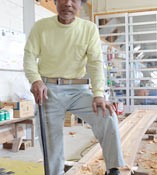
March 8, 2013 Ryukyu Shimpo
The Tokyo-based Marine Journalists Conference has decided to present the 2013 MJC Marine Award (Cultural and Dissemination Section) to Itoman traditional sabani boat-builder Kiyoshi Oshiro. For many years, 63 year-old Oshiro has made fishing boats known as sabani and has contributed to expanding their use in the fishing town of Itoman. The conference is organized by journalists and editors-in-chief of magazines that specialize in marine sports, and the award is for individuals and groups that have made significant contributions in the field of water sports and leisure activities. Oshiro is the fourth person from Okinawa to win the award.
Oshiro said, “I want to thank all those sabani boat builders who have come before me for all their efforts in inheriting the wisdom of our ancestors. I just to have been the fortunate one to win this on this occasion.”
The awards ceremony will be held on March 9, in Yokohama.
In explaining the reasons behind the award, conference representatives praised Oshiro for his contribution to Itoman by inheriting the methods of building, paddling and sailing traditional sabani. As the number of sabani builders has decreased through the years, he passed on his skills to his apprentice, Kazuaki Takara. By taking part in races, Oshiro has also displayed his own navigation skills and the superior performance of his boats.
Oshiro learned the basic methods of making a sabani after graduating from junior high school. Despite the demand for these boats having almost disappeared due to advances in shipbuilding technology, he has continued to pass on the skills required for sabani building, while at the same time working in a boat repair business. Through the years, he has built a total of about 80 sabani.
Recently, sabani have also attracted attention in the area of water sports. Oshiro downsized the vessel from the seven meters of the traditional type to around five meters in length, allowing a small number of people to enjoy it as a form of marine leisure. Oshiro said, “The role of sabani as fishing boats has come to an end. I hope to create a niche for them in the marine sport area of the tourist industry.”
(English translation by T&CT, Mark Ealey)
Go to Japanese
March 7, 2013 Ryukyu Shimpo
Superintendent of the Okinawa Prefectural Board of Education Hiroshi Oshiro commented on March 6 that the Okinawa Prefectural Government (OPG) is to consider designating the former 32nd Army Headquarters Shelter as a cultural asset. Oshiro was replying to a question from Osamu Toguchi of the Communist Party at a regular meeting of the Okinawa Prefectural Assembly. He said, “In the context of the Battle of Okinawa, we recognize the former 32nd Army Headquarters Shelter as an important site. We want to move to designate it as a cultural asset.”
Currently, the OPG Department of Environmental and Community Affairs, which is in charge of the maintenance of the shelter created under Shuri Castle during the Battle of Okinawa, has been investigating the nature of the soil at the site. At the same time, the Okinawa Prefecture Archeological Center is carrying out research on sites of World War II historical significance in the prefecture. Based on investigations being carried out by related organizations, the OPG is considering how it might best maintain the shelter. If it is designated as a cultural property, the department responsible for managing this matter will change, and the OPG will be required to preserve the site under the Law for the Protection of Cultural Properties.
According to the Cultural Assets Section of the Okinawa Prefectural Board of Education, the procedures for accreditation of cultural assets will need to be deliberated on by a council of experts, and the Agency for Cultural Affairs will also need to be consulted. This needs to happen after fiscal 2014, when the Prefecture Archeological Center completes its survey.
With regard to progress on the research, a staff member of the Cultural Assets Section said, “Inside the shelter there are the locations where there is a lack of oxygen and where there are rock falls, but we are investigating how far we can safely enter. We will continue to do this as we consult with relevant experts.”
(English translation by T&CT, Mark Ealey)
Go to Japanese
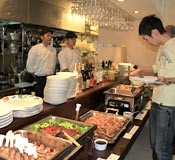
March 5, 2013 Ryukyu Shimpo
On February 28, at a restaurant in Naha, the Okinawa Prefectural Government held a tasting event to promote local goat meat and cuisine. This is a part of the 2012 Okinawa Goat Raising and Consumption Promotion Project.
About 40 people involved in the restaurant business, meat wholesalers, distribution companies, and tourist industry took part in the tasting event held at Okinawa Italian Il Mare. Eight kinds of Italian dishes with goat meat such as carpaccio and quiche were served.
The goat meat used in the dishes is a new variety bred by the Prefectural Livestock Research Center with the Boa variety from New Zealand. Il Mare chef Shinichi Yamaguchi, who developed the menu said, “Normal goat meat has a strong smell and is chewy. The newly bred goat meat smells less and could even be eaten raw. I would like to promote the meat more to young people and to women.”
Maki Tamashiro from Le Il restaurant in the Southern Beach Hotel and Resort in Itoman said, “I would like to use goat meat in our dishes.”
(English translation by T&CT, Megumi Chibana and Mark Ealey)
Go to Japanese












 Webcam(Kokusai Street)
Webcam(Kokusai Street)


